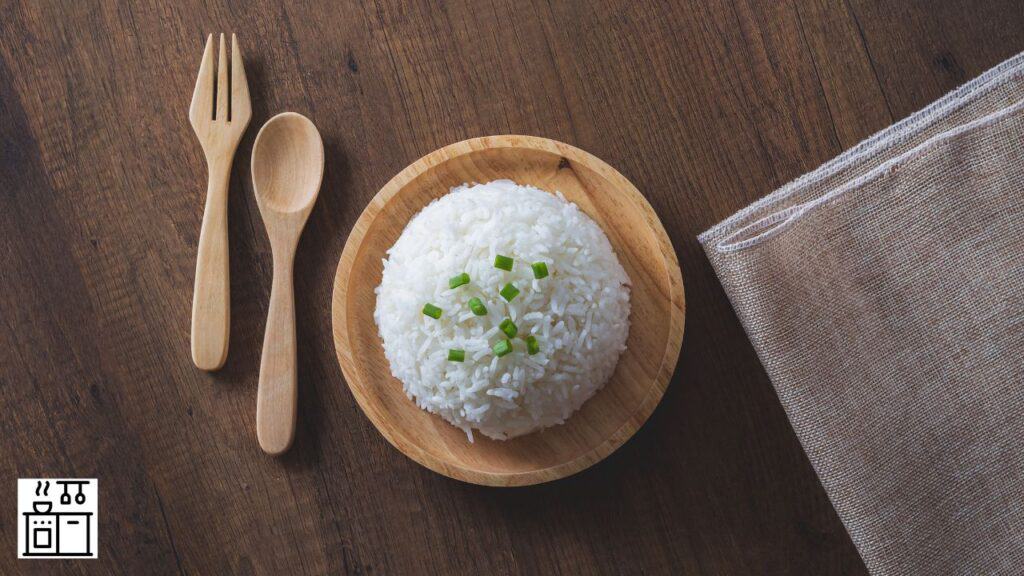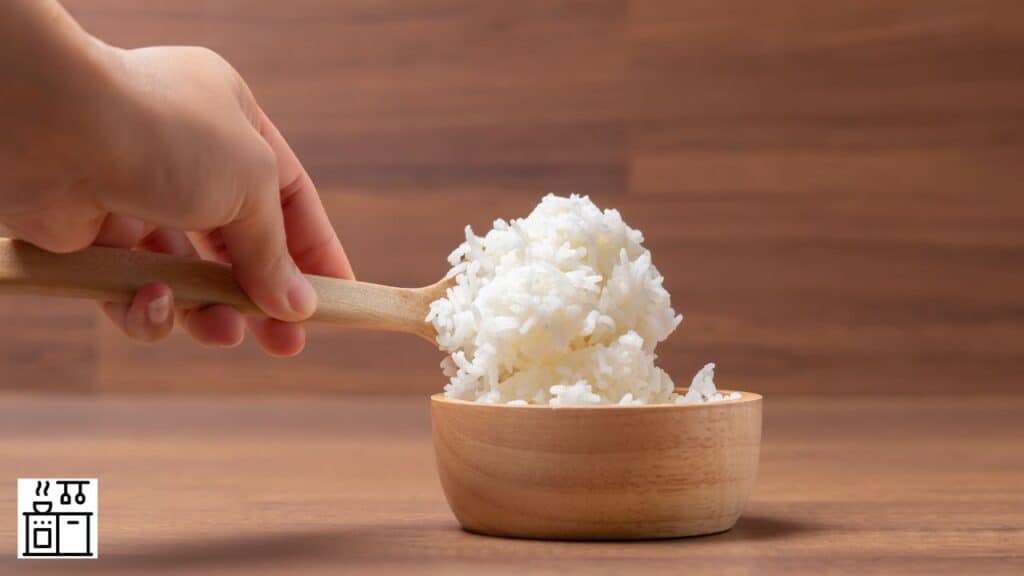Jasmine rice is thinner and smaller than most varieties of rice. So there are slight differences in the way it cooks.
Adjusting for these differences will prevent it from becoming clumpy and mushy after cooking.
You should take care of these factors even when you are cooking it in a rice cooker.
Let’s explore this in closer detail.
Steps to Prepare Jasmine Rice Perfectly in A Rice Cooker
You can ensure good results by following the below sequence of steps when cooking jasmine rice in a rice cooker.
1. Measure the Rice and Water for Cooking
Since jasmine rice is soft, it usually needs less water for cooking than other varieties of rice.
The ideal ratio of jasmine rice to water is 1:1. You can use the measuring cup that comes with the rice cooker for measuring the rice.
Alternatively, you can use any other cup or glass for measuring the rice.
The only important factor to note is to use the same cup for both the rice and water for accurate measurements.
To cook more than one cup of jasmine rice, stick to the same 1:1 ratio, and the texture will turn out just right.
2. Rinse the Rice
Before cooking the rice, wash it thoroughly. Rinsing the rice a few times will remove any dust or dirt on the grains.
Rinsing will also remove the excess starch in the rice and prevent the grains from sticking together.
To rinse the rice, place it in a mesh-lined bowl or colander and wash it under tap water a few times.
Another way is to put the rice in a bowl and fill it with water.
Agitate the grains and gently rub them against each other to dislodge starch and dirt.
Drain the water and repeat the process a few more times till the water runs clear.
3. There Is No Need to Soak the Rice
Certain varieties of rice cook better when you soak them. However, you can skip this step with jasmine rice.
The rice grains are softer. So they cook easily.
You don’t have to soak them prior to cooking. Soaking may, in fact, make the grains expand too much.
This can result in clumpy or mushy rice if you cook it for the normal duration.
4. Set up The Rice Cooker
You don’t have to activate any special functions for cooking jasmine rice in a rice cooker.
Depending on the brand and model, your rice cooker may have separate functions for different types of ingredients.
You can choose the white rice cooking function for jasmine rice. The result will be good if you use the correct rice-to-water ratio.
If your rice cooker is an advanced model with multiple functions, or you are unsure of the setting to use, consult the instruction manual.
Go with the instructions in the manual to decide the accurate setting to cook the rice.
Add the measured quantity of rice and an equal amount of water to the rice cooker to start the cooking process.
5. Season the Rice, Cover, and Cook
You can season the rice before or after cooking. If you prefer to season it before cooking, add the seasoning ingredients to the cooking water.
For one cup of rice, you can add half a spoonful of salt.
Similarly, you can also add whole spices like bay leaf or cardamoms if you want to infuse these flavors into the rice.
After adding the ingredients, close the lid of the rice cooker and switch it on.
6. Wait for The Rice to Cook
Allow the jasmine rice to cook without disturbing it. We advise against opening the rice cooker during the cooking process to check on the rice.
When you open the lid, steam and moisture will escape, slowing down the cooking process. It can make the rice chewier.
It should take around twenty to thirty minutes for most rice cooker models to cook rice.
Once the rice is ready, the cooker will automatically shut down or switch to the “Keep Warm” mode.
7. Allow the Rice to Rest
When the rice is done, the rice cooker will automatically shut down or switch to the “Keep Warm” mode.
Don’t open it right away to check on the rice.
Let it rest for five to ten minutes. This will allow the rice to absorb the remaining moisture.
After this time, open the lid and use a fork or spatula to fluff up the rice. It will help to separate the grains and make the rice softer.
After fluffing the rice, you can transfer it to a serving bowl and enjoy it.
If you are not planning to eat it immediately, use the “Keep Warm” function on the rice cooker to keep it fresh.
However, if you will not be able to use it in the next few hours, wait for the rice to reach room temperature to refrigerate it.
Tips to Improve the Texture and Taste of Jasmine Rice in A Rice Cooker

Cooking jasmine rice in a rice cooker is not very different from making it on the stovetop. But it’s comparatively easier to use a rice cooker.
When you cook jasmine rice on the stovetop, you must wait till the water comes to a rolling boil to add the rice.
However, this is not necessary for a rice cooker.
You can add the water and rice together to the inner pot and let them cook at once.
There is no need to check on the contents during the cooking process.
Additionally, the rice cooker automatically shuts down or switches off after cooking. This saves your time and makes work a lot easier.
Nonetheless, you can ensure better results by taking care of a few extra factors.
Let’s look at what they are.
1. Avoid Using Old Jasmine Rice
Rice typically doesn’t have any expiration date. Some rice tastes better when it ages too.
But, the distinct aroma and delicious flavor of jasmine rice deteriorate as it ages. So, avoid using old jasmine rice that is past its expiration date.
2. Use Bottled Water Instead of Tap Water for Cooking
Chlorinated tap water will reduce the fragrance and quality of the rice. Hence, it’s not recommended to cook jasmine rice.
Use bottled water or purified water for a better outcome.
3. Add a Dash of Olive Oil
When seasoning the jasmine rice, you can mix olive oil with the salt.
The main benefit of adding oil is that it prevents the grains from sticking. It also prevents the drying of the grains while improving the flavor.
If you don’t have olive oil, you can use sesame oil or avocado oil.
These oils will add a soft and nutty fragrance that enhances the flavor and taste of the rice.

